We hope you all had a chance of a break and a time to refresh before starting into the new year especially in these difficult times. As expected over the summer months pests have been active and we have seen all kinds in large numbers.
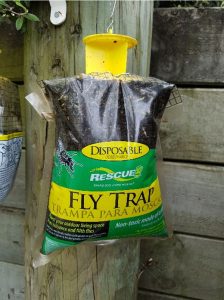
Disposable flytrap full of flies
Flies have been particularly bad in the last month we are often using a combination of treatments to control them. One useful tool is the non-toxic exterior flytraps; these catch thousands of flies before they have a chance to get inside. In a normal season these fill up over 2 or 3 months, but we are seeing them fill in just a week or two indicating the high number of flies that are around presently.
Ants have been prevalent as well many commenting they have always had problems outside but are now see them visiting inside as well. Sites where ants have always been a problem are having larger numbers infesting the property. Ants love high temperatures so when constantly above 20 degrees they become extremely active. With the dry spell we had over the holiday season and January they come inside looking for moisture even the condensation on the shower walls is enough to attract them.
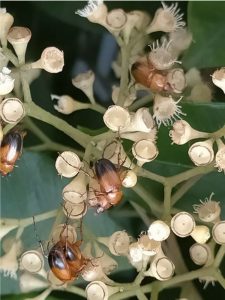
Two toned nectar scarab beetles
An interesting insect around this time of year is the two-toned nectar scarab beetle. They often invade houses in large numbers over the summer. They are attached to lights at night like moths and can be quite a problem jus by the sheer numbers to clean up. We get calls with them being mistaken for cockroaches or carpet beetles. They are feeding on pollen and nectar (as the name suggests) and are harmless it’s just the numbers that are annoying to people. An exterior building treatment is often enough to deter them from coming inside
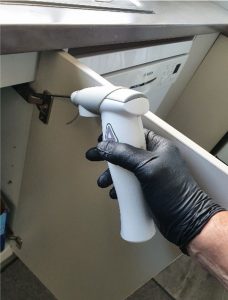
Doxem precision duster in action
Pest control is a constantly evolving field and we have received an exciting new tool for the control of German cockroaches. German cockroaches are one of the more difficult species to control due to their habit of hiding away in cracks and crevices. We have been using the Doxem precision duster for the last few months. This applies a measured dose of a very fine dry flowable powder into cracks crevices and other places the German roaches like to hide. This gets the product to where they are and the flowable nature of the product ensures it penetrates deeply into these hiding places. Not only that the product does not only work on contact but it is also a bait so the cockroaches will feed on it as well as pick it up through grooming and contact with each other. The precise dosage means only using enough product to do the job and having a lower product usage making treatments safer. It’s great to see these options that give us tools to perform our work effectively at the same time being conscious of reducing the impact of treatments we do.
Fleas

These have been a major problem this summer the humidity has led to high activity. The two most common scenarios we have now are. People returning from holiday while the pets have been in care and being eaten alive upon entering their homes. And people moving into a house that has been vacant and being attacked but thousands of hungry fleas. Why does this happen when there are no pets at the property? Fleas have a life cycle which involves several life stages egg-larvae-pupae-adult. Then the adult grows from a small flea to a larger flea.
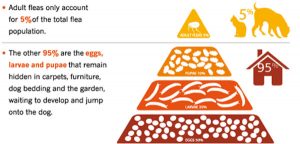
When the host animal, normally a cat or dog, moves around the flea eggs are very tiny and slippery. These fall out of the pets’ fur wherever it goes but will be concentrated more at resting and sleeping areas. These eggs that have fallen sink down into the carpet pile or cracks in the hard floors and develop into larvae. The larvae feed and develop into pupae. The pupae are a state like the cocoon of a caterpillar, the larvae are in the process of turning into an adult. Once they become an adult they then wait to emerge. Why? When the young fleas emerge, they are very tiny and aggressive this is because they are hungry. Fleas will not emerge from the pupae stage until they feel the vibration of a possible meal walking nearby. This could be the cat or dog or you. They normally hatch in 1-14 days, but the pupae can stay in this stage for up to 18 months waiting for a new host to come close enough. Therefore, when a house has been unoccupied there can be a seemingly unexplained infestation of fleas
With large numbers of fleas DIY treatments often fail to gain control. There is simply not enough product in them to eradicate all the fleas. Also, when in the pupae stage they can be protected from products that cannot penetrate the pupae case to get to the developing flea. We treat the affected area with products that are designed to exterminate the adult fleas and prevent the larvae from developing into adults. By using a combination of products, the life cycle is broken, and control is achieved.
What can be done to prevent flea infestations?
- Treat animal regularly as per vet or product instructions
- Wash pet bedding regularly hot washing will kill all life stages
- Vacuum and clean floors regularly
- Keep lawns short
- Check pets for flea while petting or grooming
If you notice a flea problem, you are best to act early under the right conditions 10 fleas can become 250 000 in as little as 30 days. When infestations get out of control, they become harder to eradicate. There is no need to suffer the distress of a severe flea problem.
If you need help with fleas or any other pest issue, give us a call or send us and email, we are happy to help. We look forward to seeing you again over the next few months.

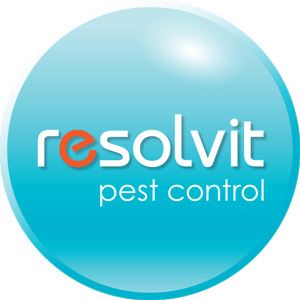
Comments are closed.